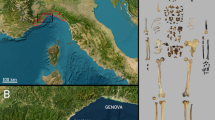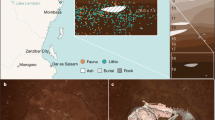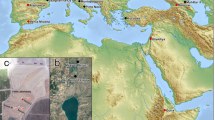Abstract
Clarifying the geographic, environmental and behavioural contexts in which the emergence of anatomically modern Homo sapiens occurred has proved difficult, particularly because Africa lacked adequate geochronological, palaeontological and archaeological evidence. The discovery of anatomically modern Homo sapiens fossils at Herto, Ethiopia1, changes this. Here we report on stratigraphically associated Late Middle Pleistocene artefacts and fossils from fluvial and lake margin sandstones of the Upper Herto Member of the Bouri Formation, Middle Awash, Afar Rift, Ethiopia. The fossils and artefacts are dated between 160,000 and 154,000 years ago by precise age determinations using the 40Ar/39Ar method. The archaeological assemblages contain elements of both Acheulean and Middle Stone Age technocomplexes. Associated faunal remains indicate repeated, systematic butchery of hippopotamus carcasses. Contemporary adult and juvenile Homo sapiens fossil crania manifest bone modifications indicative of deliberate mortuary practices.
This is a preview of subscription content, access via your institution
Access options
Subscribe to this journal
Receive 51 print issues and online access
$199.00 per year
only $3.90 per issue
Buy this article
- Purchase on Springer Link
- Instant access to full article PDF
Prices may be subject to local taxes which are calculated during checkout


Similar content being viewed by others
References
White, T. D. et al. Pleistocene Homo sapiens from Middle Awash, Ethiopia. Nature 423, 742–747 (2003)
Asfaw, B. et al. Australopithecus garhi: A new species of early hominid from Ethiopia. Science 284, 629–635 (1999)
Asfaw, B. et al. Remains of Homo erectus from Bouri, Middle Awash, Ethiopia. Nature 416, 317–320 (2002)
DeHeinzelin, J., Clark, J. D., Schick, K. D. & Gilbert, W. H (eds) The Acheulean and the Plio-Pleistocene Deposits of the Middle Awash Valley, Ethiopia (Royal Museum of Central Africa, Tervuren, Belgium; Ann. Sci. Geol. 104, 2000).
Katoh, S., Nagaoka, S., WoldeGabriel, G., Beyene, Y. & Suwa, G. Preliminary study on geomorphological development since the early Pleistocene in Konso-Gardula area (KGA), southern Ethiopia. Proc. Gen. Meet. Assoc. Jpn. Geogr. 49, 208–209 (1996)
Howell, F. C. Paleo-demes, species clades, and extinctions in the Pleistocene hominin record. J. Anthropol. Res. 55, 191–243 (1999)
Stringer, C. B. in The Age of the Earth: From 4004 BC to AD 2002 (eds Lewis, C. L. E. & Knell, S. J.) 265–274 (Geological Society of London, Spec. Publ. 190, 2001)
Tryon, C. A. & McBrearty, S. Tephrostratigraphy and the Acheulian to Middle Stone Age transition in the Kapthurin Formation, Kenya. J. Hum. Evol. 42, 211–235 (2002)
Clark, J. D. in A Very Remote Period Indeed: Papers on the Palaeolithic Presented to Derek Roe (eds Milliken, S. & Cook, J.) 1–18 (Oxbow Books, Oxford, 2001)
Hours, F. in Proceedings of the Seventh Panafrican Congress of Prehistory and Quaternary Studies, 1971, Addis Ababa (eds Abebe, B., Chavaillon, J. & Sutton, J. E. G.) 99–104 (Ministry of Culture, Addis Ababa, 1976)
Chavaillion, J., Chavaillon, N., Hours, F. & Piperno, M. From the Oldowan to the Middle Stone Age at Melka-Kunturé (Ethiopia): Understanding cultural changes. Quaternaria 21, 87–114 (1979)
Clark, J. D. in Hominid Evolution: Lifestyles and Survival Strategies (ed. Ullrich, H.) 277–292 (Edition Archaea, Berlin, 1999)
White, T. D. Prehistoric Cannibalism at Mancos 5MTUMR-2346 (Princeton Univ. Press, 1992)
White, T. D. & Toth, N. The question of ritual cannibalism at Grotta Guattari. Curr. Anthropol. 32, 118–138 (1991)
Pickering, T., White, T. D. & Toth, N. Cutmarks on a Plio-Pleistocene hominid from Sterkfontein, South Africa. Am. J. Phys. Anthropol. 111, 579–584 (2000)
White, T. D. Cutmarks on the Bodo cranium: A case of prehistoric defleshing. Am. J. Phys. Anthropol. 69, 503–550 (2000)
Acknowledgements
J.D.C., a legend in African archaeology, founded and co-led the Middle Awash project until his death in February 2002. We thank A. Almquist, A. Asfaw, M. Asnake, T. Assebework, D. Brill, J. DeHeinzelin, A. Getty, Y. Haile-Selassie, A.-R. Jaouni, B. Latimer, C. Pehlevan, K. Schick, S. Simpson, P. Snow and Y. Zeleka for fieldwork and analytical studies; the Earth Environmental Sciences Division, Los Alamos National Laboratory, for access to electron microprobe and other support; D. DeGusta, F. C. Howell, C. O. Lovejoy, L. Hlusko, F. Bibi, R. Klein, L. Jellema and E. Vrba for review and/or assistance; and J. Feathers, and J. Westgate and A. Sandhu for assessing the feasibility of luminescence and fission track dating, respectively, on some of the tephra. We thank the Ministry of Youth, Sports and Culture, the Authority for Research and Conservation of the Cultural Heritage, and the National Museum of Ethiopia for permissions; the Afar Regional Government and the Afar people of the Middle Awash, particularly the Bouri–Modaitu community and H. Elema; and many additional individuals for contributions. This research was supported by the NSF (US), the Institute of Geophysics and Planetary Physics (University of California at Los Alamos National Laboratory), and the Japan Society for the Promotion of Science. Additional financial contributions were made by the Hampton Fund for International Initiatives, Miami University.
Author information
Authors and Affiliations
Corresponding author
Ethics declarations
Competing interests
The authors declare that they have no competing financial interests.
Supplementary information
Rights and permissions
About this article
Cite this article
Clark, J., Beyene, Y., WoldeGabriel, G. et al. Stratigraphic, chronological and behavioural contexts of Pleistocene Homo sapiens from Middle Awash, Ethiopia. Nature 423, 747–752 (2003). https://doi.org/10.1038/nature01670
Received:
Accepted:
Issue Date:
DOI: https://doi.org/10.1038/nature01670
This article is cited by
-
Longstanding behavioural stability in West Africa extends to the Middle Pleistocene at Bargny, coastal Senegal
Nature Ecology & Evolution (2023)
-
Age of the oldest known Homo sapiens from eastern Africa
Nature (2022)
-
The Emergence of Habitual Ochre Use in Africa and its Significance for The Development of Ritual Behavior During The Middle Stone Age
Journal of World Prehistory (2022)
Comments
By submitting a comment you agree to abide by our Terms and Community Guidelines. If you find something abusive or that does not comply with our terms or guidelines please flag it as inappropriate.



